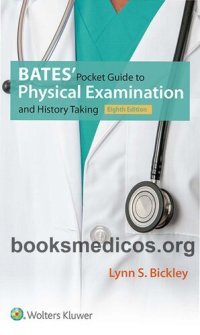
Ebook: Bates' Pocket Guide to Physical Examination and History Taking
Author: Lynn S. Bickley
Access physical assessment techniques in a flash—anytime, anywhere!
This concise and trusted reference provides authoritative guidance on how to perform the patient interview, physical examination, and other core assessments as well as how to apply clinical reasoning and use shared decision-making in a quick-reference format—all based on a firm understanding of clinical evidence.
Bates’ Pocket Guide to Physical Examination and History Taking includes illustrated, step-by-step techniques that outline the correct performance of the physical examination in an easy-to-follow two-column format featuring examination techniques on the left and abnormalities (clearly indicated in red) with differential diagnoses on the right. This highly regarded pocket guide also covers special stages in the life cycle—infancy through adolescence, pregnancy, and aging.
New to the eighth edition:
Text boxes help readers quickly find important summaries of clinical conditions and other relevant information.
Many New and updated photographs and illustrations support the text, and figures are now numbered for easy identification and reference.
Rewritten chapter on evaluating clinical evidence clarifies key concepts to ensure student understanding.
Revised and expanded chapter on the skin, hair, and nails includes New dermatology photographs and provides the framework for assessing common lesions and abnormalities.
Updated behavior and mental status chapter now references DSM-5 .
Significantly revised information on obesity and nutrition counseling; cardiovascular risk factor screening and New clinical guidelines; New screening guidelines for breast cancer, colon cancer, Papanicolau smears, and stroke risk factors; current information on STIs; New geriatric assessment tools; and much more provide essential clinical updates.
New life-cycle content includes an increased emphasis on cardiovascular health promotion and child development; updated pregnancy topics such as weight gain, substance abuse, and intimate partner violence; and New information on the older adult, including frailty, immunizations, cancer screening, cognitive decline and dementia screening, and a New algorithm for falls prevention.
This concise and trusted reference provides authoritative guidance on how to perform the patient interview, physical examination, and other core assessments as well as how to apply clinical reasoning and use shared decision-making in a quick-reference format—all based on a firm understanding of clinical evidence.
Bates’ Pocket Guide to Physical Examination and History Taking includes illustrated, step-by-step techniques that outline the correct performance of the physical examination in an easy-to-follow two-column format featuring examination techniques on the left and abnormalities (clearly indicated in red) with differential diagnoses on the right. This highly regarded pocket guide also covers special stages in the life cycle—infancy through adolescence, pregnancy, and aging.
New to the eighth edition:
Text boxes help readers quickly find important summaries of clinical conditions and other relevant information.
Many New and updated photographs and illustrations support the text, and figures are now numbered for easy identification and reference.
Rewritten chapter on evaluating clinical evidence clarifies key concepts to ensure student understanding.
Revised and expanded chapter on the skin, hair, and nails includes New dermatology photographs and provides the framework for assessing common lesions and abnormalities.
Updated behavior and mental status chapter now references DSM-5 .
Significantly revised information on obesity and nutrition counseling; cardiovascular risk factor screening and New clinical guidelines; New screening guidelines for breast cancer, colon cancer, Papanicolau smears, and stroke risk factors; current information on STIs; New geriatric assessment tools; and much more provide essential clinical updates.
New life-cycle content includes an increased emphasis on cardiovascular health promotion and child development; updated pregnancy topics such as weight gain, substance abuse, and intimate partner violence; and New information on the older adult, including frailty, immunizations, cancer screening, cognitive decline and dementia screening, and a New algorithm for falls prevention.
Download the book Bates' Pocket Guide to Physical Examination and History Taking for free or read online
Continue reading on any device:

Last viewed books
Related books
{related-news}
Comments (0)